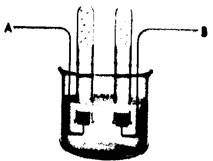
Interpretation: The given
Concept Introduction: In an
Explanation of Solution
The given diagram is as follows:

In the electrolysis of brine, electrolyte other than water is taken which can be more easily oxidized or reduced is taken. This will result in the formation of products of electrolysis other than hydrogen and oxygen. In the electrolysis of brine, the aqueous solution of sodium chloride is taken.
This results in the formation of three products that is chlorine gas, hydrogen gas, and sodium hydroxide. In the electrolysis process, oxidation of chloride ions takes place at the anode to form chlorine gas. The reduction reaction of water takes place to form hydrogen gas at the cathode. Here, water molecules get easily reduced to hydrogen gas as compared to sodium ions; thus, sodium metal is not formed.
Here, the electrolyte solution becomes sodium hydroxide as the reduction of water also produces hydroxide ions.
The reactions at the cathode and anode are represented as follows:
Anode-Oxidation:
Cathode-Reduction:
Thus, the overall reaction will be:
Here, a spectator sodium ion is also introduced in the reaction. Thus, the overall reaction becomes:
Thus, the given diagram can be modified to show the electrolysis of brine as follows:

It shows the same amount of hydrogen and chlorine gas produced in the reaction as the number of moles are same.
Chapter 21 Solutions
Chemistry 2012 Student Edition (hard Cover) Grade 11
 ChemistryChemistryISBN:9781305957404Author:Steven S. Zumdahl, Susan A. Zumdahl, Donald J. DeCostePublisher:Cengage Learning
ChemistryChemistryISBN:9781305957404Author:Steven S. Zumdahl, Susan A. Zumdahl, Donald J. DeCostePublisher:Cengage Learning ChemistryChemistryISBN:9781259911156Author:Raymond Chang Dr., Jason Overby ProfessorPublisher:McGraw-Hill Education
ChemistryChemistryISBN:9781259911156Author:Raymond Chang Dr., Jason Overby ProfessorPublisher:McGraw-Hill Education Principles of Instrumental AnalysisChemistryISBN:9781305577213Author:Douglas A. Skoog, F. James Holler, Stanley R. CrouchPublisher:Cengage Learning
Principles of Instrumental AnalysisChemistryISBN:9781305577213Author:Douglas A. Skoog, F. James Holler, Stanley R. CrouchPublisher:Cengage Learning Organic ChemistryChemistryISBN:9780078021558Author:Janice Gorzynski Smith Dr.Publisher:McGraw-Hill Education
Organic ChemistryChemistryISBN:9780078021558Author:Janice Gorzynski Smith Dr.Publisher:McGraw-Hill Education Chemistry: Principles and ReactionsChemistryISBN:9781305079373Author:William L. Masterton, Cecile N. HurleyPublisher:Cengage Learning
Chemistry: Principles and ReactionsChemistryISBN:9781305079373Author:William L. Masterton, Cecile N. HurleyPublisher:Cengage Learning Elementary Principles of Chemical Processes, Bind...ChemistryISBN:9781118431221Author:Richard M. Felder, Ronald W. Rousseau, Lisa G. BullardPublisher:WILEY
Elementary Principles of Chemical Processes, Bind...ChemistryISBN:9781118431221Author:Richard M. Felder, Ronald W. Rousseau, Lisa G. BullardPublisher:WILEY





